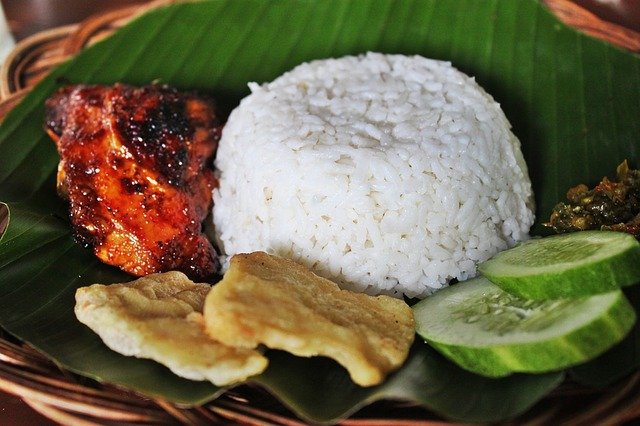
After a delicious meal, we usually end up with leftover food, which makes us feel guilty to just throw it away. Reheating leftover foods is a great way to save time and money since some of these can be as good and healthy after reheating once or twice.
However, improper storing and reheating of leftover foods especially chicken and rice can cause the bacteria to grow and leads you to experience food poisoning such as diarrhea and stomach cramps.
So, can you reheat chicken and rice? Leftover chicken and rice can be reheated but they need extra care when reheating since some reheating method can cause food poisoning and makes these foods less appealing to eat.
Chicken is one of the most favorite dishes to partner with rice, commonly found in restaurants, fast foods, gatherings, and mostly cooked at home even without special occasions.
It becomes part of the weekly meal plan, but improper reheating makes these foods to dry out.
How Can I Perfectly Reheat Chicken Without Making It Dry?
Here are the simple steps to reheat the chicken to keep it tender and juicy using the three most common electric cookware such as microwave, oven, and stove.
Reheating Chicken in Microwave
Step 1: Preparing the leftover chicken for reheating
If the chicken is frozen, you need to defrost it first. Afterward, cut the chicken into smaller pieces, especially if it is a breast or thigh part, to shorten the reheating time in the microwave because heating it for too long makes the chicken dry out.
Place the chicken on a microwave-safe plate with enough space between each piece. Then add 1-2 tablespoons of chicken broth and cover it with a damp cloth to maintain the humidity and prevent it from drying out.
Step 2: Heating with the Interval of 1 Minute
Put the chicken inside the microwave for exactly 1 minute, then take it out, turn the other side of the chicken and return for an additional 1 minute of heating.
If the chicken is not hot enough, you can repeat the process once or twice until you make sure it is deliciously juicy and tender.
Reheating Chicken in Stove
Step 1: Preparing the Leftover Chicken for Reheating
You should also cut the chicken into smaller pieces to heat evenly side by side than heating it in large sizes. Afterward, turn the stove into medium heat, pour a small amount of oil, and add a chicken broth that allows the chicken to keep tender and juicy.
Step 2: Put the Chicken in Heated Pan
Put the chicken in a pan and keep a space between each piece to avoid sticking. Watch it carefully; turn the chicken every now and then to prevent it from burning.
If you did not cut the chicken into smaller pieces, remember that it takes a longer time to heat up inside the meat.
Reheating Chicken in Oven
Step 1: Preparing the Leftover Chicken for Reheating
If the chicken is frozen, defrost it first, cut it into smaller pieces, and put it in an oven-safe pan. Keep an even space between the pieces of chicken, and you can add broth or a little bit of water before covering it with aluminum foil or a cookie pan to avoid drying it out.
Step 2: Put the Chicken in Oven
First, preheat the oven to 425 to 475 °F to ensure that the oven is at the right temperature before reheating the chicken. When the oven is finally preheated, you can now place the smaller chicken pieces, which only takes 20 to 30 minutes to achieve tenderness.
However, if you are reheating large sizes of chicken, you have to wait longer. Still, the best option is to cut it 2 to 3 times smaller than the large size.
The Best Way to Reheat Rice to Keep It Fluffy
Rice has almost always been part of the table, and it is undeniable how most of us includes rice in our daily meal. We frequently have a bowl of leftover rice that we store in the refrigerator to reheat for our next meal.
So, here are some of the simple steps to properly reheat rice using the three common electric cookware such as microwaves, stove, and oven.
Reheating Rice in Microwave
Step 1: Preparing the Leftover Rice
First, you need to get the amount of rice you wanted to reheat in the refrigerator and transfer it to a microwaveable plate or bowl. Add 1 to 2 tablespoons of water to every cup of rice in a bowl and cover it with a damp paper towel.
Step 2: Put the Rice in a Microwave
Place the leftover rice in the microwave and reheat it for 3 to 4 minutes, or until it becomes totally hot all throughout. You can also check the inside temperature of rice, which needed to be at least 165°F or higher. You can check the temperature using a food thermometer.
Reheating Rice in Stove
Step 1: Preparing the Leftover Rice
After getting the rice in the refrigerator, it is important to let the rice at room temperature for approximately 20 to 30 minutes before placing it in a skillet. Add at least 2 tablespoons of water for every cup of rice you are heating to keep it fluffy and yummy.
Step 2: Put the Rice in a Pan
After the first step, cover the pan with leftover rice and set the stove into low to medium heat. Allow to reheat for 3 to 5 minutes and stir the rice every now and then until it becomes evenly hot to prevent it from sticking in the pan or to avoid forming clumps.
Reheating Rice in Oven
Step 1: Preparing the Leftover Rice
Pour the rice into the ovenproof tray and break the clumps using a spatula. Spread the rice and spray enough water or vegetable stock to avoid drying it out. Then, cover it with an aluminum sheet.
Step 2: Put the Rice in Oven
Bake the rice at 300°F for at least 15 to 30 minutes until it becomes evenly hot. Afterward, if you are not yet ready to prepare other dishes, you can turn off the oven and keep the rice inside since the excess heat in the oven can still make the rice evenly warm.
Can You Reheat Chicken and Rice More than Once?
Reheating food is a budget-friendly and sensible move to avoid wasting money. That’s why we keep storing leftover foods in the refrigerator.
However, there is a rule of reheating perishable food ONLY ONCE.
Reheating Chicken
You could definitely reheat chicken more than once or as much as you wanted as long as it is piping hot all throughout at 75 degrees Celsius. If not, it might cause you food poisoning such as diarrhea and vomiting, which usually last around a day.
To make sure that the chicken is hot enough before eating it, you can use a food thermometer and place it in the center of the dish.
Reheating Rice
When the rice is taken out in the refrigerator to reheat, the bacteria called “Bacillus cereus spores” have the chance to grow and multiply. Reheating rice more than once can cause food poisoning, and reheating it multiple times can put you at higher risk.
It is important to reheat rice only once. If exceeded, you might experience diarrhea and stomach discomfort caused by the bacterium Bacillus cereus, especially if you have a sensitive stomach.
Still, some people with insensitive stomachs may not experience the negative effect, but it is advisable to follow the rules of reheating rice only once for a healthy lifestyle.
How Long Can I Store Leftover Chicken and Rice in Refrigerator?
Leftover chicken is a kind of meat that is most closely associated with bacteria that causes food poisoning; that why it is necessary to store it correctly.
However, some people forget the maximum days of storing the leftover chicken that only lasts 3 to 4 days in the fridge while it can last for about 1 to 6 months in the freezer.
Leftover rice will last depending on how it was cook, cooled, and stored. If the rice is stored correctly, it will last for about 4 to 6 days in a fridge and about 6 months in an airtight container in the freezer.
However, Celeste Perez, a nutritionist, stated that 3 to 4 days is good enough to keep the leftover rice in the fridge. Still, it is not advisable to completely rely on this because you might throw it earlier than the maximum rules depending on the quality of rice and storing procedure.
Final Thoughts
It is always the best idea to reheat leftover chicken and rice. This is the safest way to keep the foods safe to eat.
Do not eat any leftover foods that are not reheated because they could contain bacteria that can bring danger to your health. I hope this helps. To learn more about reheating foods, do not forget to visit this page.

